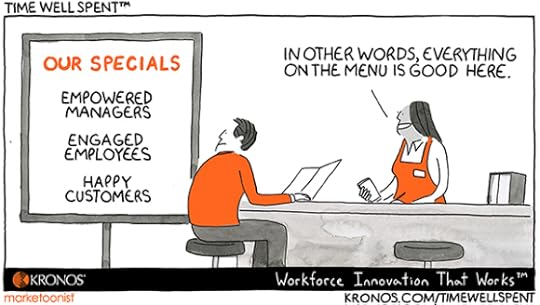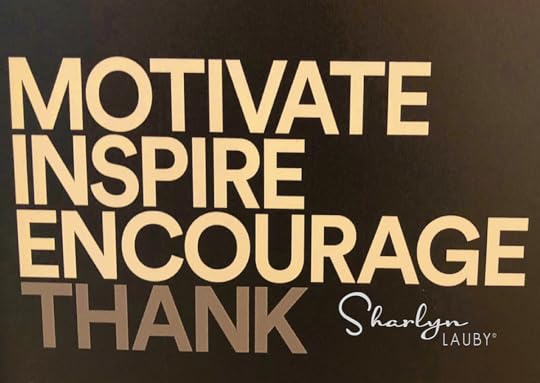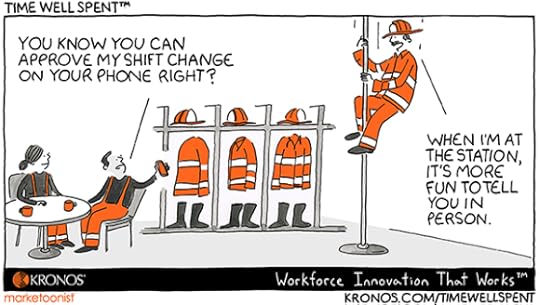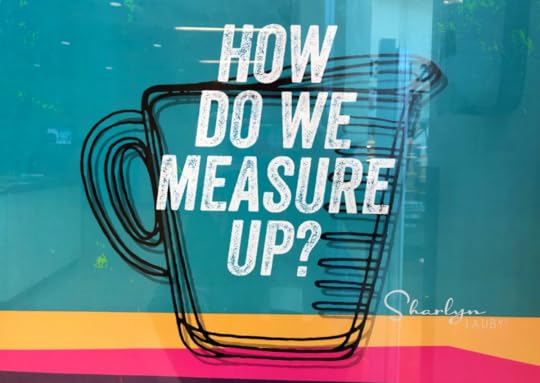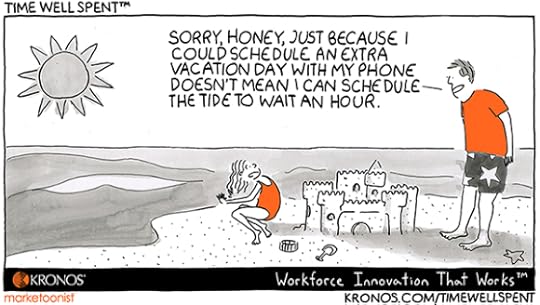Sharlyn J. Lauby's Blog, page 107
November 19, 2018
Employees Need to Learn About Happiness
And not just during Happy Hour!
Yale University’s most popular class ever is called “The Science of Well-Being”. And you can take it for free on Coursera. Just out of curiosity, I did. And I could see how it might make sense to incorporate this program (or something like it) in employee training and development. Here are a few reasons why:
Happiness is about judgment and decision-making. The professor for this course, Laurie Santos PhD, started the course sharing the G.I. Joe fallacy, which is that the age-old mantra of “knowing is half the battle” really doesn’t help when it comes to making real-world decisions. So, if we want employees to be happy and satisfied, then we need to retire the idea that just giving employees information is enough.
Happiness means knowing what will make us happy. Santos also talks about the concept of “miswanting”. This is the idea that individuals think they want something a lot more than they do or that they believe they will like something a lot more than they actually will. An example might be the employee who wants to be promoted, then once they get the promotion, there’s a bit of remorse.
I’m bringing this up because, in the world of work, we often have to deal trade-offs that can impact happiness. An employee is presented with an opportunity to make more money, but it means being on the road more. Or an employee can work from home, but their job responsibilities will change. For employees to make good decisions, they need to truly understand what makes them happy. In addition, they need to have a greater understanding of how to make the decision, not just have the information but have enough self-awareness to know the conditions that are right for them.
The last thing employers want is for an employee to make wrong decisions where their careers are concerned. Santos suggested a catchy acronym that individuals could use in evaluating decisions and taking action. It’s called WOOP:
W = wish for what you want
O = outcomes are defined
O = obstacles are identified
P = plan your strategy
For me, the real success in the WOOP method is in the W. Wishing for what you want means understanding what makes you happy. I don’t know about you, but no one ever talked about this in school or college. I’ve learned what makes me happy over lots of years and many mistakes. “The Science of Well-Being” could be one of those courses that helps individuals focus on happiness. And hopefully not use trial and error as the way to reach it.
There’s an increasing conversation about money not buying happiness and how happiness impacts personal well-being. But it only works if you know what happiness really is. Maybe it’s time to find out.
Image captured by Sharlyn Lauby while exploring the streets of Miami, FL
The post Employees Need to Learn About Happiness appeared first on hr bartender.






November 16, 2018
Know What Makes You Special – Friday Distraction from #HR Bartender
When I saw this Time Well Spent from our friends at Kronos, I knew I had to share it with you. It’s one of those messages that applies whether you’re an individual, team, or organization.
Do you know what makes you special? And can you articulate it?
As a person, do you know your strengths? Not only the things that you believe you do really well, but what about what others say you do really well? If you don’t, consider an exercise to figure it out. On a personal level, find a time with no distractions where you can create a list. Struggling to start? Call it a list of “The 5 Reasons Any Company Should Hire Me”.
If your organization offers 360 or multi-rater reviews, take one to learn what others feel are your strengths. Keep in mind, you’ll also learn your weaknesses, but that’s okay. We all have areas we need to improve. Or just ask your manager. Maybe during your next 1:1 meeting, tell them what you’re trying to do and give them some time to think about it.
From a team perspective, do you know why you’re asked to participate on teams? And when you ask others to work on a project with you, do you share why you’re asking? While sometimes our job title drives participation on a work team or project team, in many cases it’s our knowledge and skills. When your boss asks you to join a meeting or buy-into a special project, listen for the reason why. And if they don’t tell you, maybe you should ask.
The same goes for when we ask others to work with us. We should tell them. For example, if you’re a high-level, strategic thinker and need a detail-oriented, execution person to offer the counter-point, tell them. Or if as much as you try, your meetings tend to get off track and you want someone to come in and gently get things focused every once in a while…tell them. They (and you) can do a better job when they know the reason for their participation.
Finally, when it comes to the company, do you know why customers buy your product or service? I mean really know. I’ve seen organizations be surprised by the answer. They thought it was service and it ends up being cost. Or they think it’s cost and it ends up being response time. Once you discover what makes the organization unique and special, the question becomes how and when are you promoting it?
This also applies to recruiting. Does human resources know why candidates apply with the company? Do they know why employees stay? And if so, when and how is HR sharing that information with candidates and employees? Organizations could include the information on the company’s career portal. They could talk about it during interviews. Mention it during orientation. Let employees know during town hall meetings.
“What makes you special?” sounds like such a simple question. But it’s hard to get good, accurate information. Once you do, use it to your fullest advantage. It can help you as a person in your professional development. It can help teams bring together the right people. And it can help organizations find and keep the best talent.
The post Know What Makes You Special – Friday Distraction from #HR Bartender appeared first on hr bartender.






November 15, 2018
Employees: What To Do When Placed On Suspension -Ask #HR Bartender
When an employee is placed on suspension pending investigation, the passing time can seem to take forever. It makes sense for HR to keep employees up-to-date on what’s happening. At least, that’s what this reader wants to know…
Hi. l work in housekeeping and was suspended by HR because the chef said that l threatened him. There was no witness to confirm his allegation. Ten days after my suspension, the union was at the hotel to hear both sides of the story. My concern is that, since l’m bipolar, the hotel knows that after a month l am out of the system and l will not be able to get my medication. If the case they are alleging is hearsay, why is it taking so long?
Dear reader: I honestly wish I had a clear definitive answer. I’m not making excuses, but investigations do take time. How much time depends on the situation and what the organization starts to uncover as they interview employees, etc. In the past, I’ve published some articles about accommodations, investigations, and suspensions that might be helpful.
Working with a Job Accommodation
When Employees Want to Go “On the Record”
What Happens During an Employee Investigation?
Can HR Reopen an Employee Investigation?
Can I Get Fired for an Accident?
What to do If You’re Placed on Suspension
How to Handle a Work Suspension
Should an Employee Resign or Wait to Be Fired
Employees: When Should You Lawyer Up
I’d like to extend a HUGE thanks to the attorneys who help me answer these types of questions. They certainly don’t have to. They have full-time jobs and always say “yes” as a way to help the profession.
I know it might be tough to empathize with someone on suspension if you’ve never been suspended. But that doesn’t mean we can’t empathize with someone who is waiting to hear whether or not they have a job. Because we’ve all been there. While conducting an investigation or placing an employee on suspension is never fun, we owe it to employees to conduct a thorough investigation in a timely fashion.
Image captured by Sharlyn Lauby just off Duval Street in Key West, FL
The post Employees: What To Do When Placed On Suspension -Ask #HR Bartender appeared first on hr bartender.






November 13, 2018
10 Financial Skills That Every Manager Needs
I ran across an article on the Association for Talent Development site titled “Financial Skills Every Manager Should Be Able to Navigate”. It’s a good read. Got me thinking…if I had to come up with a list of financial skills that every manager should know, what would they be? These are financial skills that managers should learn in a management development program or during manager onboarding.
Read the company financials. I remember working for an organization where all new managers had a meeting with the controller to learn how to read the company financials. I was amazed that more organizations didn’t do this. After being exposed to the practice, I made it a point in every job I held to ask the controller for a meeting. They always said yes.
Analyze the company financials. It’s not enough to know how to read the financials. You have to know how to pull information from them and make business decisions based on what’s there. So, step one is learning how to read the financials but step two is being able to do something with them.
Understand business insurances. Risk management and insurance are big ticket items in an organization. I’ve been surprised a few times that managers didn’t know the company held employment practices liability insurance (EPLI). I’ve also surprised a few managers when I had to explain that the company’s EPLI insurance was being cancelled … and why.
Prepare a budget. Preparing a household budget and a department budget aren’t the same thing. Sad to say, but the budgeting process can be a bit of a “game” in some organizations. Managers need the financial skills to understand this and know how to budget so they can accomplish the department’s goals – and their goals.
Manage a budget. Like reading the financials, it’s not enough to simply know how to create a budget. Managers have to be able to work within budgetary guidelines. Especially when it comes to shifting expenses and reforecasting revenues. There are do’s and don’ts within organizations, which are often not written down anywhere.
Create employee schedules. Payroll is a huge organizational expense, so understanding how to create a good schedule translates into proper resource management. Overscheduling and under scheduling impacts the bottom-line. It also gets tricky because managers want to create schedules that make employees happy too. And that can often create conflict.
Monitor employee time and attendance. Scheduling isn’t a “set it and forget it” activity. Once a schedule is created, managers need to monitor it and possibly make last minute adjustments – an employee calls in sick, someone is late, or the business levels aren’t at expected levels. Managers need the financial skills to know how to make schedule changes.
Understand employee compensation. Managers should at least understand the basics of compensation, such as how pay grades are established, what’s salary compression, and why red lining employees isn’t good for employees or the business. Managers are asked to make salary recommendations, so give them the knowledge to do it well.
Prepare an RFP (request for proposal). In today’s gig economy, an increasing number of organizations are using freelancers, contractors, or consultants for projects. While a company’s procurement or purchasing department might handle some of these tasks, they will often come to managers to get details.
Evaluate a proposal. And once an RFP has been issued, managers need to be able to review and evaluate what’s been submitted. Ask bad questions on the RFP and you’ll get bad answers. This will not help the organization make good financial decisions and get work completed in the most efficient way possible.
BONUS: There’s one other area in financial skills that managers would benefit from knowing, and that’s operational metrics, including human resources metrics. I’ve learned a lot from managers sharing with me how certain operational metrics they track impact the bottom-line. For example, how an airline’s on-time performance impacts each department. I’ve always understood the logic, but they showed me the numbers.
In turn, I was able to show them how cost per hire and turnover impact the company in real dollars as well. A learning opportunity for everyone!
Managers have a financial responsibility to the organization. And often their personal compensation is tied to their ability to manage the company’s finances. It’s in everyone’s best interest to make sure managers have the skills to do it well.
Maybe HR should create a manager’s financial skills training course? I’m curious. Has anyone done that? Love to hear your thoughts.
Image captured by Sharlyn Lauby at the WorkHuman Conference in Austin, TX
The post 10 Financial Skills That Every Manager Needs appeared first on hr bartender.






November 11, 2018
How to Find the Right Resume Writer – Ask #HR Bartender
A couple of weeks ago, I shared a reader note that dealt with two subjects: working as a temp and having your resume professionally prepared. Just in case you missed it, here’s the reader note again:
I’m a struggling “wannabe HR professional”. By that I mean, my resume is all over the place. I’ve been a temp worker for so long. I feel like I’m unsuccessful when it comes to landing great HR positions. Instead I keep landing recruiting coordinator roles, and to me it’s not HR.
I’ve paid over $300 to get a professional resume and I feel as though I was taken advantage off. What advice would you give someone like me?
In the first part of this series, I spoke with Joan Ciferri, former president of a regional staffing company about temporary work: why people are attracted to it and how to build a good working relationship with a staffing company. I hope you’ll check out the article.
Today, I want to deal with the second part of the note: resume writing. To help us understand more about finding a good (and professional!) resume writer, I asked my friend Chris Fields for assistance. He’s an expert resume writer and human resources consultant who helps job seekers with their resumes, cover letters, LinkedIn profiles, and job search strategies over at ResumeCrusade.com. Chris has helped us before – this post about which job title to use on your resume is one of my favorites.
Chris, what’s the best way to find a resume writer?
[Fields] First of all, I’d like to say that I’m sorry to hear about someone having a negative experience with a resume writer. As a resume writer, I know one of my client’s top concerns is “Am I going to be ripped off?”
I always tell people to vet your resume writer carefully. Have a conversation with them and, if they are unwilling to speak to you, that’s not a good sign for sure. Three things that someone might want to ask a resume writer include:
What’s the process?
Do you have any testimonials or ‘real people’ that can verify your work?
Can I see examples of your work?
Let’s expand on this conversation a bit more. What types of questions should someone ask a resume writer to make sure they’re qualified?
 [Fields] I like when my clients ask tough questions about how my process stands out from the others. I want them to know that I am going to work with them to get their resumes in the best shape possible.
[Fields] I like when my clients ask tough questions about how my process stands out from the others. I want them to know that I am going to work with them to get their resumes in the best shape possible.
Also, I talk with clients about the initial process and then the correction process. As a resume writer, I need to know how much time clients can give me in terms of answering questions and request corrections, so we can meet the timeline for the project.
One other thing to consider: I suggest going with a person over a service. Resume services have become automated, so everything is a template for a faster turnaround. Individuals should ask if the resume writer uses templates.
I’m not going to ask you to disclose pricing. But if I were in the market to have my resume professionally prepared, what types of questions should I ask a resume writer specifically about pricing?
[Fields] Some people only want to pay $100 for a resume. Just understand that you get what you pay for.
Others will pay $1,000 or more. Personally, even though I am a resume writer, I do not feel anyone should be paying $1,000 for a resume only. If we are talking about a resume, cover letter and LinkedIn optimization, then sure $1,000 – $1,500 is right, but for a resume only? No.
You should have a reasonable budget set aside for a resume writer. Depending on career level (entry level to executive) it could be as low as $150 to as much as $500 or $600 dollars. $300 is a good starting ballpark amount for a customized resume and not some templated document.
As you’re thinking about your resume budget, think about how many old resumes or documents you have that the new resume writer would have to read and research. The more stuff that the resume writer has to examine and analyze to make you the best resume, that will factor in the cost.
Most importantly, whatever the price point is, don’t be afraid to negotiate. The resume writer will tell you their price but maybe they are open to knocking a few dollars off.
What types of questions should someone expect a resume writer to ask them?
[Fields] I’ve already mentioned a few in terms of the process. But once the process gets started, they should ask you about:
Job duties
Strengths as an employee
Major accomplishments
Valuable results from your hard work
Future career goals
It sounds like, if the resume writer and client do all of the right things on the front end, the result will be a fantastic resume. But if someone wasn’t pleased with the end result, do they have any recourse? How could they let the resume writer know?
[Fields] First, before saying anything, ask yourself what you don’t like about the resume and why. And what you think is missing.
I will be honest, I have had clients tell me that they were unhappy with the finished product and when I ask what it is that they do not like about it, they say, “I don’t know.” or “I’m not sure, I just don’t like it.” For me, it is hard to fix something if you can’t tell me what’s broken. So, I usually start from the top down, “Do you like the heading?” or “Okay, so do you like the “Career Profile”? And I continue all the way down, including the bullet points.
So first, figure out what you don’t like about it. Then, contact the resume writer and let them know specifically what you don’t like and see if they are willing to explain and/or change it.
One last question. I know our conversation has been focused on resume writing. But what would you say to the reader who is frustrated about being a recruiting coordinator.
[Fields] There is nothing wrong with a recruiting coordinator role, in fact some would say HR’s most important job is recruiting because if you can’t recruit then you won’t have a team of workers to do any other HR functions.
Well said, Chris. I can’t think of a better closing.
Many thanks to Chris for sharing his expertise with us. I hope you’ll take a moment to connect with him on Twitter at @ResumeCrusade and check out his blog at The Resume Crusade.
Image captured by Sharlyn Lauby after speaking at the HR Technology Conference in Las Vegas, NV
The post How to Find the Right Resume Writer – Ask #HR Bartender appeared first on hr bartender.






November 9, 2018
Technology Doesn’t Replace People – Friday Distraction
(Editor’s Note: Today’s post is brought to you by our friends at Kronos , a leading provider of workforce management and human capital management cloud solutions. Kronos is hosting a free eSymposium for HR and payroll professionals next week. The event is also eligible for professional development credits. Check it out and enjoy today’s article!)
You probably know I love my technology gadgets. One of the things I love about technology is it allows me to interact with people I wouldn’t otherwise ever meet. Case in point: years ago, I connected with Jennifer V. Miller on Twitter. We have a lot in common. We’re both in the learning and development space and we’re both writers.
After connecting on Twitter, we decided to connect on Facebook. I got to learn about her life in Michigan. And she heard all about my life in Florida. Recently, we discovered that we were both at the same conference. So, we had dinner. It was fabulous. We talked about work, home, etc. Our technology connection turned into a real conversation.
That’s why I couldn’t help but smile when I saw this Time Well Spent from our friends at Kronos. Workplace technology helps us do a lot of things. And workplace technologies are very effective and efficient. But that doesn’t mean we can’t sit down and have an honest to goodness real-life conversation every once in a while.
Use technology to build relationships. Networking a decade ago involved a never-ending schedule of association meetings and banquet chicken dinners (you know the ones). And networking today still involves a bit of that. It’s not all bad. But it also involves connecting with people online. Social media can help build relationships.
Use technology to enhance relationships, not replace them. Take advantage of opportunities to chat in person with employees or colleagues. Relationships help us get things done. People will remember when you took the time to talk with them. Especially when it’s time to ask for a favor.
Using technology doesn’t mean you have to always be “on”. The Workforce Institute at Kronos has been sharing a series on the topic of “always being on” when it comes to technology. Check it out when you have a moment. Our relationship with tech doesn’t have to be “use it until we’re completely stressed out by it, then quit.”
I will be the first one to admit that life on social media today is different than it was a decade ago. Back then, you pretty much just saw what everyone was eating and today, politics comes up a lot. But there are still pockets of fun and opportunities to connect and engage with incredibly smart and talented individuals.
Those connections can be valuable. They can be fun. Don’t miss out on them. Not only in making the connection but turning it into something personal.
The post Technology Doesn’t Replace People – Friday Distraction appeared first on hr bartender.






November 8, 2018
Microlearning: 5 Reasons Your Company Should Consider It
There are many different types of learning: social learning, mobile learning, and elearning are just a few. A relatively new type of learning that’s attracting attention is microlearning. Think of it as small learning units or bite sized pieces of content.
We use microlearning on a regular basis – we just don’t call it microlearning. Here’s an example. I recently wanted to roast a chicken and, to prepare the chicken, I wanted to truss it. But I didn’t know how. So I went on YouTube, found a two-minute video and viola! I knew how to truss a chicken. People are using short videos to learn all the time.
Which is exactly why organizations might want to consider adding microlearning to their offerings. Here are a few things to consider when discussing microlearning as part of your current learning strategy:
It’s easy to produce. Please notice I didn’t say cheap. Although by definition, microlearning would be shorter than standard training and therefore should be cost effective to produce, it’s possible an organization would have more microlearning options available. That being said, I can see microlearning topics being less complex to design and implement than, let’s say, a traditional elearning project.
It’s flexible. Microlearning can be classified as “on demand” if participants can access it whenever and wherever they wish. It could also be called “just-in-time” if it’s used to refresh/remind/teach someone something immediately before they need it. For example, a manager may want to review the steps of counseling an employee right before meeting with them.
It fits today’s technology. One of my mantras is making stuff “easy to buy and easy to use.” Meaning that people who are trying to engage with the organization shouldn’t get the run-around. Because microlearning is focused on a single concept, it can be created using a simplistic process, it can be easy for the company to share, and easy for employees to view.
It can complement your existing programs. I’ve already mentioned microlearning being able to provide a refresher or reminder. It can do that as a follow-up to a traditional classroom learning experience. Instead of searching for the paper participant guide, an employee can search for the microlearning session. It can provide a solution in a moment of need.
It could be a coaching tool. I think of coaching as being able to help someone reach their goals. Part of helping someone could be sharing with them resources that will improve their skills and knowledge. Managers could use microlearning as part of their employee coaching toolbox. When an employee is stuck and needs some assistance, a manager could recommend microlearning sessions.
There are so many different ways we can learn. That’s a good thing because participants can find a learning method that they connect with. I also understand it’s difficult from a corporate learning perspective because how do you justify the time and resources to create all these different learning methods.
The new learning methods emerging right now – concepts like microlearning – have tremendous flexibility and can bring us a return on investment in more ways than one. Something that traditional classroom training might not be able to do. It doesn’t mean ditch classroom training – it means give microlearning a try.
P.S. I’m very excited to be facilitating a virtual seminar for the Society for Human Resource Management (SHRM) on L&D: Developing Organizational Talent. We’ll be talking about how to design learning initiatives. Details about the learning objectives can be found on the SHRM website. I hope you can join us.
Image captured by Sharlyn Lauby at the 34th Street Graffiti Wall in Gainesville, FL
The post Microlearning: 5 Reasons Your Company Should Consider It appeared first on hr bartender.






November 6, 2018
Employee Check-Ins: 6 Essential Components for Success
(Editor’s Note: Today’s post is brought to you by our friends at Readex Research, which provides expert online and mail survey services to help businesses understand their internal and external customers. Their services include employee experience surveys. Enjoy the post!)
Over the past few months, we’ve talked about the importance of “checking in” with new hires to make sure their employee experience is going well. This activity can take place in-person or online. The goal with a new hire check-in is to make sure that employees are in a position to focus on their work, which ultimately fosters employee engagement and retention. Here are a couple of resources you might want to check out:
New Hire Onboarding: Take a Pulse to Increase Employee Retention
New Hires Not Engaged? How to Design an Onboarding Intervention
But I’ve spoken with many people who tell me that the challenge isn’t about convincing anyone that check-ins are valuable. Organizations know that. The challenge is in designing a check-in process that the organization will embrace.
6 Essential Elements for Successful New Hire Check-Ins
Check-ins should meet the needs of the company as well as the employee. I know it might seem like a check-in is all about the employee…and it is. But if the process is cumbersome or expensive, then organizations run the risk of having no one do it. And that defeats the purpose of getting employee feedback. So here are six things to consider:
Check-ins must meet the needs of the company and the employee. Let’s start with how a new hire check-in should meet the company’s needs:
1. Low on administration. But high on value. This is the beauty of today’s technology. Organizations can have activities, like a new hire check-in, that are scheduled to distribute automatically. This doesn’t mean the organization doesn’t care just because someone in HR wasn’t sitting at their desk hitting the ‘send’ button. Rather, automating a regularly occurring process allows the company to focus on the piece that cannot be automated…dealing with employee responses.
2. Clear goals. Speaking of results, the only way that a check-in program brings value is when the organization is positioned to react to the new hire’s responses. That involves establishing clear program goals and designing questions that will provide the company with relevant feedback. The questions shouldn’t be leading the new hire to respond a certain way and they should be designed to give the new hire the feeling that their comments are welcome.
3. Timely. The whole reason that the organization is doing new hire check-ins is to encourage employee engagement and prevent unnecessary turnover. Asking a new hire after six months on the job what they thought about their first day doesn’t send the message that the company cares. Check-ins allow organizations to send brief surveys to new hires on regular intervals, so the feedback can be heard and responded to in a timely fashion.
New hire employee needs are somewhat similar. Here are a few things to consider:
4. Convenient. If organizations want employees to respond, then they need to create activities that are easy to use so it encourages participation. Personally, I know my response rate when someone asks me to respond to a five-question survey versus the one that will take 20-minutes. Employees need to also feel that they can keep their comments confidential and, if they wish, they can leave their contact information for follow-up. Let new hires drive their own feedback.
5. Intuitive. Whatever method is used to deliver the check-in, it needs to be user friendly. There’s nothing worse than offering to give feedback and then having to jump through a bunch of hoops to finish the process. It might be tempting to add other goals to the check-in process because you have the employee’s attention. Resist that urge. Also, if the feedback will be given over a technology platform, make sure it’s mobile responsive and secure.
6. Timely. Like the organization, new hires don’t want to waste time. But for new hires, the focus is a bit different. They want to deliver their feedback quickly and efficiently, so they can get on with their work. They also want the organization to respond in a timely fashion. Doing so, will encourage employees to keep on providing even morefeedback. I’ve said it before, but I’ll say it again, the worst thing organizations can do is ask for an employee’s feedback and then do nothing with it.
I asked Readex CEO Jack Semler if there was one aspect of check-ins that might be more important than the others. While I knew he would tell me they’re all important, he did share that the key comes down to connection.
“Thinking from my own experience as a manager, I feel what is ‘most important’ is a two-fold: First, is the new employee connecting with what the job really is and what the employee’s personal vision of the job is? If reality isn’t in line with their vision, then danger exists, and has to be corrected immediately. Second, is the new employee connecting with peers and management in a positive, good way? There are so many other factors that need to be checked out, but in the end, if what the job entails is not in line with the employee expectations, and good relationships aren’t forming, the employee may be a flight risk.”
New Hire Check-ins Help Retain Employees
Employee check-ins are a valuable way to easily and quickly take a pulse on the new hire experience. For example, surveys are only as good as they are structured. In this case, structure means making it easy to take the survey and easy to interpret the results – for the employee and the organization.
If you want to learn more about how to implement an employee check-in program, visit the Readex website. You can see first-hand how technology can help your organization retain employees and maintain engagement and productivity.
The post Employee Check-Ins: 6 Essential Components for Success appeared first on hr bartender.






November 4, 2018
Using a Temporary Job to Launch Your Career – Ask #HR Bartender
Sometimes we can get a huge lift in our career from the unlikeliest places. We just need the right information and mindset. Today’s reader note is a perfect example.
I’m a struggling “wannabe HR professional”. By that I mean, my resume is all over the place. I’ve been a temp worker for so long. I feel like I’m unsuccessful when it comes to landing great HR positions. Instead I keep landing recruiting coordinator roles, and to me it’s not HR.
I’ve paid over $300 to get a professional resume and I feel as though I was taken advantage off. What advice would you give someone like me?
First off, there are two separate issues in this note: 1) working in a temporary job and 2) having your resume professionally prepared. Since these are both big issues in today’s job market, I’m going to respond in two articles. Today, we’re going to focus on the temporary staffing part.
To help us learn more about staffing agencies, I reached out to a friend of mine, Joan Ciferri,who wasthe president of a regional staffing firmfor over 25 years.
Joan, for those people who might not know, what’s the function of a staffing company as it relates to a temporary job?
[Ciferri] Most staffing companies concentrate on non-exempt positions. They normally have a specialty such as:
Administrative, includingaccounting and finance
Humanresources
Information technology
Light or heavy industrial
Staffing companies acquire a client company’s business to fill the company’s positions in their niche. Most candidates start out as a temporary or contract worker on the staffing company’s payroll for a specific time period for peak business times, special projects, or coverage for a worker who is out on leave.
 Many client companies chose to hire the best of these workers if they have an open position because they have had the opportunity to view their work product and habits. Most staffing companies allow their clients to hire their temporary worker after a 90-day period with a nominal or no additional fee. If a client wishes to hire the temporary worker prior to the contracted period, they may do so by ‘buying out’ the contract. Since the staffing company normally is placing several candidates with a client company, they tend to be well connected to the hiring managers and supervisors. They’re in a good position to recommend other candidates to the client company who would fit their environment. Staffing companies get paid when they place someone with the client company on assignment or directly with the company.
Many client companies chose to hire the best of these workers if they have an open position because they have had the opportunity to view their work product and habits. Most staffing companies allow their clients to hire their temporary worker after a 90-day period with a nominal or no additional fee. If a client wishes to hire the temporary worker prior to the contracted period, they may do so by ‘buying out’ the contract. Since the staffing company normally is placing several candidates with a client company, they tend to be well connected to the hiring managers and supervisors. They’re in a good position to recommend other candidates to the client company who would fit their environment. Staffing companies get paid when they place someone with the client company on assignment or directly with the company.
How is this different from a search firm?
[Ciferri] Search firms (also called executive search or headhunters) concentrate on higher-level exempt positions. Search firms tend to specialize in positions and/or, more often, in a particular industry. Their recruiters are usually knowledgeable in that industry, so they can understand the client company’s and candidate’s background and needs. Search firms typically are engaged to fill a specific role or roles in the company. Client companies typically pay the search firm for the process of the search regardless if they hire the person.
The client company has specific guidelines of the skills and experience they are looking for and the search company will search both passive and active candidates who fit this description.
Why do people choose a temporary job?
[Ciferri] People choose temp work for a variety of reasons such as:
Filling in the employment gap while looking for full-time employment or employment in their field.
Allowing for flexibility to travel or pursue interests that would require periodic time away from work.
Helping them determine the type of work or company that could be a fit for them.
Enjoying the variety and find working for only one employer limiting or boring.
In your experience, do companies regularly hire temps for HR departments? If so, what are the typical temp positions in HR?
[Ciferri] Yes. The most common temporary positions are for recruiters to assist them with ramping up projects or peak periods. Some companies hire HR or administrative temporaries for large benefit open enrollment periods or mergers. Some companies will hire a temporary HR generalist to start a department or cover for their HR person who may be out on Family and Medical Leave (FMLA).
If someone is working through a staffing firm, but wants full-time work, what are 1-2 things they should tell the staffing company before they take an assignment?
[Ciferri] Tell the staffing firm that they want full time work. Have an agreement about what will happen if they get a job offer or interview for full time work while on assignment for the temp company.
In this reader note, the person sounds frustrated or unhappy. If someone is unhappy or disappointed with their temporary job, what should they do?
[Ciferri] Let the staffing company know right away so they can help rectify the situation or replace them. Do not just leave the client company and temp company without notice.
My thanks to Joan for sharing her expertise with us. An increasing number of individuals and organizations are looking for flexibility when it comes to talent. Staffing companies and a temporary job can fill that need. But it takes understanding what a staffing company does best. And openly communicating your needs.
Image captured by Sharlyn Lauby after speaking at the HR Technology Conference in Las Vegas, NV
The post Using a Temporary Job to Launch Your Career – Ask #HR Bartender appeared first on hr bartender.






November 2, 2018
Understanding the Limits of Convenience – Friday Distraction
Regular readers of this blog know I’m a planner. I plan everything. I think I’d even plan spontaneity.
That’s why I couldn’t help but laugh at this Time Well Spent from our friends at Kronos. It reminded me that, even though we can do a lot of things with planning, there are some things that just shouldn’t be planned. Nor should people be penalized for making last-minute changes to a plan.
Allow employees to make last-minute changes. I completely understand that our business operations rely on employees showing up. But we all know that there are times when an employee might want to take the day off and we could get by without them. Having a flexible scheduling system is a win for everyone.
Make sure employees know the limits of the system. The cartoon points out that you can’t schedule the tide. Every system will have some limitations. That doesn’t make it a bad system. But letting employees know how the system works, will help them use it properly.
Tell employees the consequences of using the system incorrectly. Flexible systems are wonderful, but in addition to telling employees all of the terrific features, it’s important to share the consequences of using the system incorrectly or inappropriately. It could have an impact on the operation. With convenience comes responsibility.
One of the major advantages in using technology is convenience. We can create schedules, distribute them to employees, and allow employees to make changes. All using technology.
None of this is designed to scare anyone away from flexible technology. In fact, technology solutions with lots of options is exactly what we want. We can customize the solution to our organization. But everyone needs to understand the ground rules: how the system works, how employees are expected to use the system, and what happens if employees don’t use the system appropriately.
The post Understanding the Limits of Convenience – Friday Distraction appeared first on hr bartender.






Sharlyn J. Lauby's Blog
- Sharlyn J. Lauby's profile
- 10 followers



